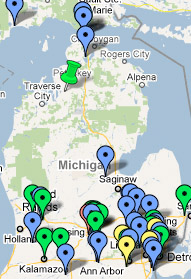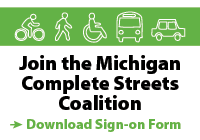You are currently browsing the monthly archive for November 2009.
Proving that we haven’t forgotten about Michigan’s upper half, we here at the Michigan Complete Streets Coalition want to share some good news from the Upper Penninsula’s most populous city.
Marquette residents awoke two weeks ago to find their city a bit more walk- and bike-friendly. On October 29th, road workers completed a resurfacing project on a one-mile portion of Wright Street, which runs east to west on the city’s north end.
Aside from resurfacing, the project also included work to reconfigure Wright Street, taking it from four lanes of traffic down to two lanes and a center turn lane, with room leftover to add four-foot wide bike lanes on either side. Engineers across the country are putting roads like Wright Street on a “road diet”, finding out in the process that their streets become leaner, safer, and more efficient.
Based on their comments, city officials seem hesitant about committing to the reconfiguration as anything more than a temporary experiment. But if the Wright Street experiment is anything like other road diet projects, city officials will soon be singing the praises of fewer crashes and improved safety. In fact, the data shows that using road diets and complete streets planning principles not only makes the our streets safer and more productive, it can also help encourage increases in commercial and residential property values, and can spur new development.
Kudos to Marquette city officials for taking that kind of risk.
Taking a stroll? Ann Arbor is the safest city in Michigan to do it, while Flint is the most dangerous according to a national report released today.
Overall, the number pedestrians killed each year in Michigan is above the national average (12.2% in Michigan, compared with 11.8% nationally). Cities including Lansing, Grand Rapids and Jackson scored favorably, while Detroit, Monroe, and others scored well below the national average. Click here for the complete data on Michigan.
More than 4,500 Americans died last year while walking in the nation’s cities and towns. In Michigan, 253 pedestrian fatalities were recorded in 2007 and 2008.
The report—Dangerous by Design: Solving the Epidemic of Preventable Pedestrian Deaths—was authored by Transportation for America and the Surface Transportation Policy Partnership. It was released in Michigan through the Michigan Environmental Council.
The report shows that communities that invest in safe, complete streets — those that encourage pedestrians, cyclists and motorists to coexist safely — are the safest places to walk. Walk- friendly policies and infrastructure should be a key pillar of policies to encourage revitalization of urban cores throughout the state.
Unfortunately, only a trickle of transportation funding is used to address pedestrian safety. Pedestrian deaths account for 12 percent of all traffic deaths, yet only 1.5 percent of funds available in the current federal transportation bill are directed toward pedestrian safety.
 The American Planning Association and the National Complete Streets Coalition have launched a research project on complete streets. The effort is intended to transform community planning, urban design, and engineering street design practices to better meet the needs of all forms of vehicular and non-vehicular transportation — cars, transit, pedestrians, (including pedestrians with disabilities), and bicyclists.
The American Planning Association and the National Complete Streets Coalition have launched a research project on complete streets. The effort is intended to transform community planning, urban design, and engineering street design practices to better meet the needs of all forms of vehicular and non-vehicular transportation — cars, transit, pedestrians, (including pedestrians with disabilities), and bicyclists.
You can learn more about this great new resource at: http://www.planning.org/research/streets/
MDOT to provide assistance in developing policies
The 2010 budget process has finally come to an end. The good news is complete streets language remain in the final transportation budget (Public Act 116 of 2009).
The complete streets section, however, was weakened into intent language, meaning that MDOT and local road agencies are encouraged but not required to develop and adopt complete streets policies. While we are disappointed that complete streets are still not yet mandatory, we are pleased to announce that language in this bill does state that “the department [MDOT] shall provide assistance to and coordinate with local road agencies and metropolitan planning organizations in developing complete street policies, including the development of model complete street policies.”
We are currently looking into who the proper contact is at MDOT to direct inquires regarding assistance with the development of complete streets policies.
Read the rest of this entry »















